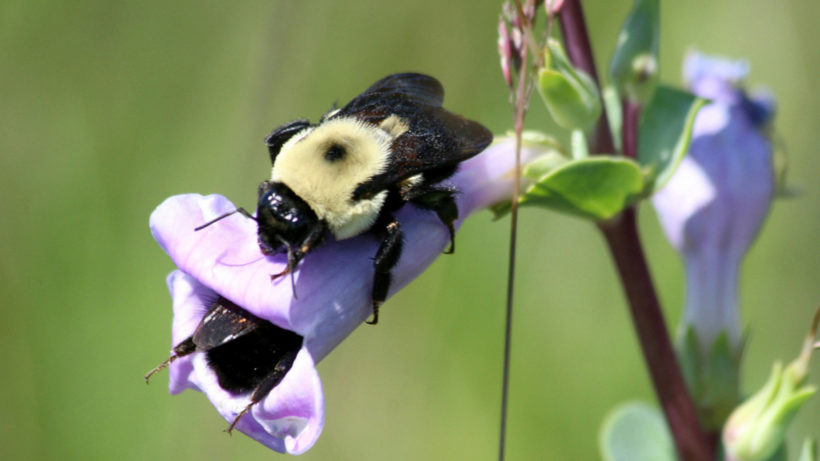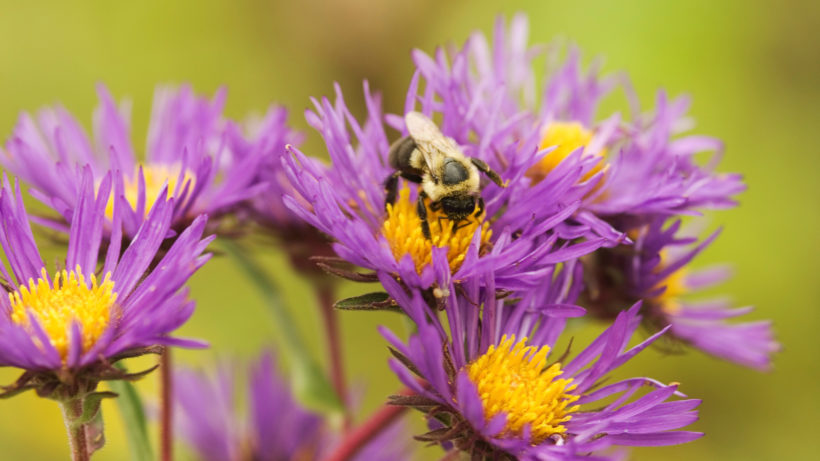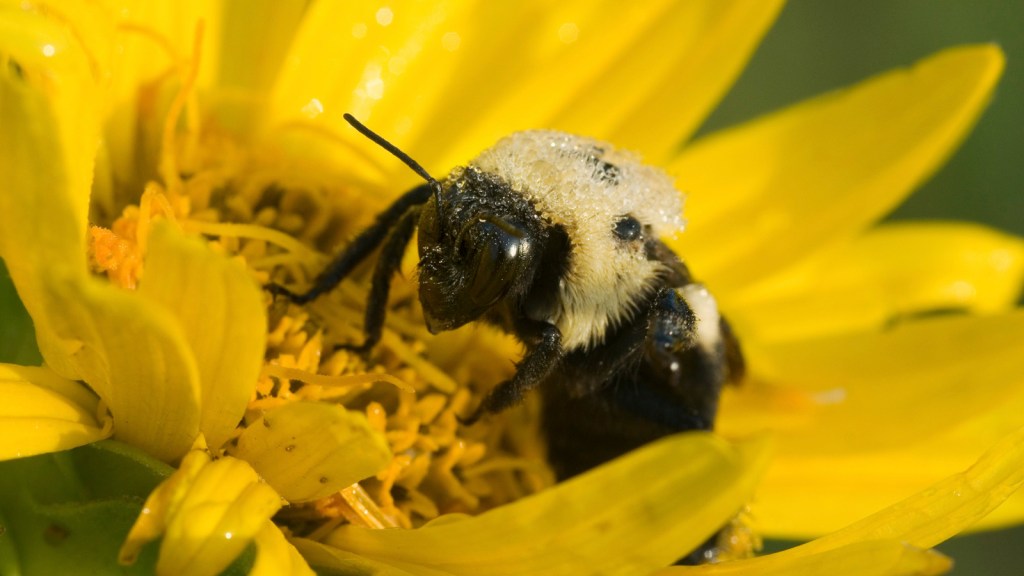You’ve probably heard about the problems facing honey bees across North America, as hives disappear in the face of “colony collapse disorder.” You also undoubtedly know that this loss of pollinators could have severe impacts on food production.
But you may not know this: honey bees get the press, but they’re not the only pollinator in trouble. In fact, native bumble bees have been facing even more alarming declines across the continent.
This loss of bumble bees could have severe consequences for native ecosystems and for agriculture.
Bumble bees are perhaps the most charismatic of all bee species: they’re fuzzy, colorful and non-aggressive. And they’re one of the very few insects to inspire a symphony.
They’re also vital pollinators – more important to ecosystems than the non-native honey bee. Fifty species of North American bumble bees pollinate native plants, which in turn produce flowers and seeds that feed everything from songbirds to grizzly bears.
The Xerces Society, an organization devoted to invertebrate conservation, reports that bumble bees are also the most important pollinators for blueberries, cranberries, clover, greenhouse tomatoes and other crops.
But they’re in decline. According to the Xerces Society:
“At least four species of formerly common North American bumble bees have experienced catastrophic declines over the past decade – two of them may be on the brink of extinction. Preliminary investigations by many scientists indicate that a number of other formerly common species are also less abundant than they were in the past.”
What’s going on here? Is there anything conservationists can do about it?

Where Have All the Pollinators Gone?
An incident in an Oregon parking lot last summer dramatically illustrated the plight faced by native pollinators.
At a mall parking lot in Wilsonville, people began finding dead bumble bees – unbelievable numbers of dead bumble bees. It turned out to be the largest bumble bee die-off ever recorded, with more than 50,000 dead bees littering the area.
A wildlife mystery? Not quite.
It turns out that someone had sprayed 55 flowering trees with a pesticide known as a neonicotinoid, legal for use but deadly for insects, including beneficial ones like pollinators.
How many other times do such die-offs occur, out of sight of people? As the Xerces Society’s executive director Scott Black said in a Grist interview, “If these events had not happened over areas of concrete, I am not sure anyone would have ever noticed. The insects would just fall into the grass to be eaten by birds as well as ants and other insects.”
Oregon has since restricted the use of some neonicotinoid pesticides to protect native pollinators. Currently, on the federal level, Representatives John Conyers (D-MI) and Earl Blumenauer (D-OR) have drafted a bill that will suspend use of the worst neonicotinoid pesticides and direct EPA to perform a deeper evaluation of their impacts on pollinators — Saving America’s Pollinators Act.
In addition to pesticides, bumble bees face a long list of other threats – habitat loss, climate change, competition from non-native bees, introduced diseases.
According to the Xerces Society, habitat loss in particular is having a profound effect on bumble bees (and other native pollinators).
Bumble bees need a mix of native plants to feed on as well as grassy areas to burrow. They once found this habitat in plenty on the edges of farms and yards, and even in roadside ditches. But there has been a tendency to “clean up” – to remove the wilder edges around human development.
That’s bad for bees and other pollinators.
A neatly trimmed grass lawn may be green but it’s not green – especially if it is sprayed with pesticides and all native plants are removed.
We often think of habitat loss as an irreversible problem, or one that can be solved only by intensive restoration activities. If a subdivision goes in and takes out part of a wolverine’s range, it is not like you can plant a few trees and bring back wolverines.
But with bumble bees, you can reverse habitat loss. Yards, ditches and abandoned lots can make a big difference. Your personal actions can native pollinators – protecting not only cool critters but also vital ecosystem services.

How You Can Be Bee Friendly
Bumble bees live across North America, Europe and Asia in a wide variety of habitats and climates. Adding some flowering plants to your yard will add some variety to the neighborhood, and also benefit bumble bees.
The Xerces Society gets you started with a complete guide to home gardening for bumble bees. Ideally, you can add a mix of flowering plants that bloom in the spring, summer and fall – providing a more year-round food source.
There’s a great satisfaction in creating your own wildlife haven, and it is probably easier than you think.
My wife Jennifer, who runs the agriculture program for the Northwest Center for Alternatives to Pesticides, tore out our front yard nine years ago and replaced it with drought-tolerant and native high desert plants (appropriate for our arid environment in Boise, Idaho).
Admittedly, the neighbors expressed some consternation when we tore out a “perfectly good lawn.”
We don’t hear those complaints any more, as the yard is alive with beautiful wildflowers, waving tall grasses and cover-providing bushes.
We have fence lizards and valley quail and goldfinches and dragonflies. And we have pollinators. Lots of pollinators. Including bumble bees.
Bumble bees are generalists – they don’t key in on a specific flower. They move from species to species, buzzing around our lawn. We can mark spring by when the first bumble bees show up.
But this year, we won’t just be watching them. We’ll be photo-documenting the bees and sending info to researchers. This initiative, Bumble Bee Watch, is one more way you can assist with pollinator conservation.
With 50 species of bumble bees, it can be hard to track population trends. Bumble Bee Watch asks citizen scientists to photograph any bumble bees they see and report them. You can download a handy bumble bee identification guide, and Bumble Bee Watch can help you identify species.
The news about pollinators can often seem grim. But wherever you live, this is definitely a conservation issue where your actions can have a direct influence.
Plant some flowers, watch for bumble bees and lay off the pesticides – you’ll be well on your way to creating your own pollinator preserve!





This year I’ve noticed a great decline of the normal bumblebees and other bees like wasps. The only bees I have seen are the wood boring bees. I don’t understand what happened to him all last year there was plenty of these around now this year there’s nothing. Who’s going to pollinate all my flowers and Gardens?
Good Afternoon,
I tore an old shed that is a hazardous and I was not aware that there were bumble bees making their home inside the shed. I would like to purchase a home for them – so I can attach it to the new shed. Where can i go and what should i buy. I need this asap since i do not want to distrubed them more that what we have done. I feel awful. Please advise.
Hi Eva, Thank you for the question! We can’t endorse any one product or vendor, but I did see several options when I searched online for bumblebee house. You can also find some info on how to build one from the Xerces Society here: http://www.xerces.org/wp-content/uploads/2008/11/nests_for_native_bees_fact_sheet_xerces_society.pdf
What to do about lace bugs if not some kind of poison?
Matt – How about a handy ID Guide for Eastern bumble bees?
Hey man, I am not a problem
I have 2 butterfly, bee, hummingbird gardens and no bees. What can be done to get them back? I really miss my little buddies.
Please help.
I have not seen even one bumble bee this year. Even now that the is clover all around and that’s a first.